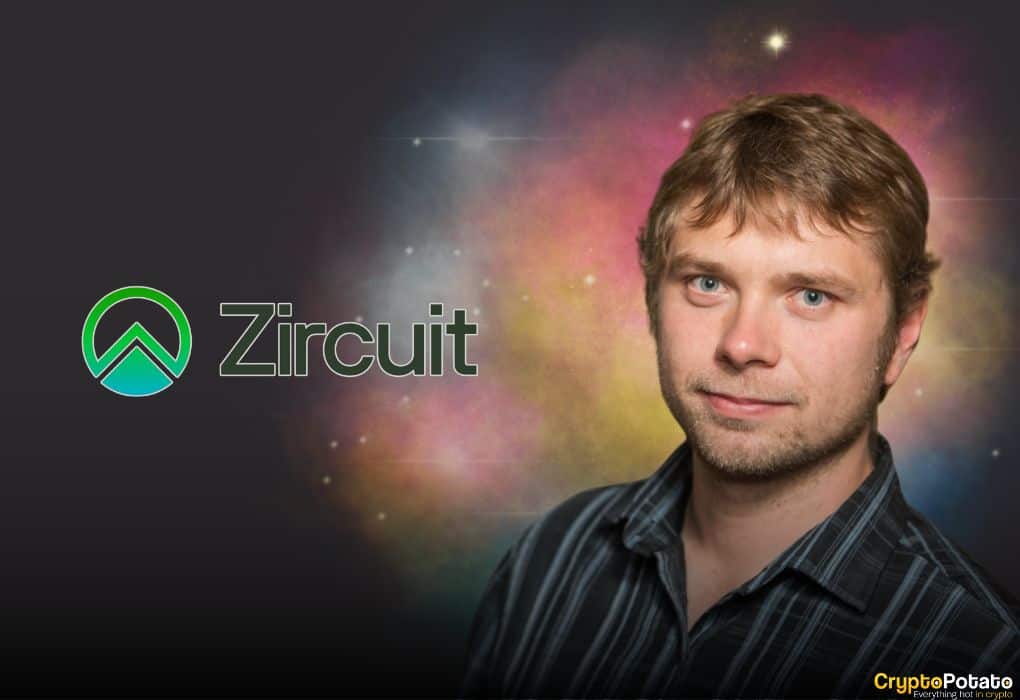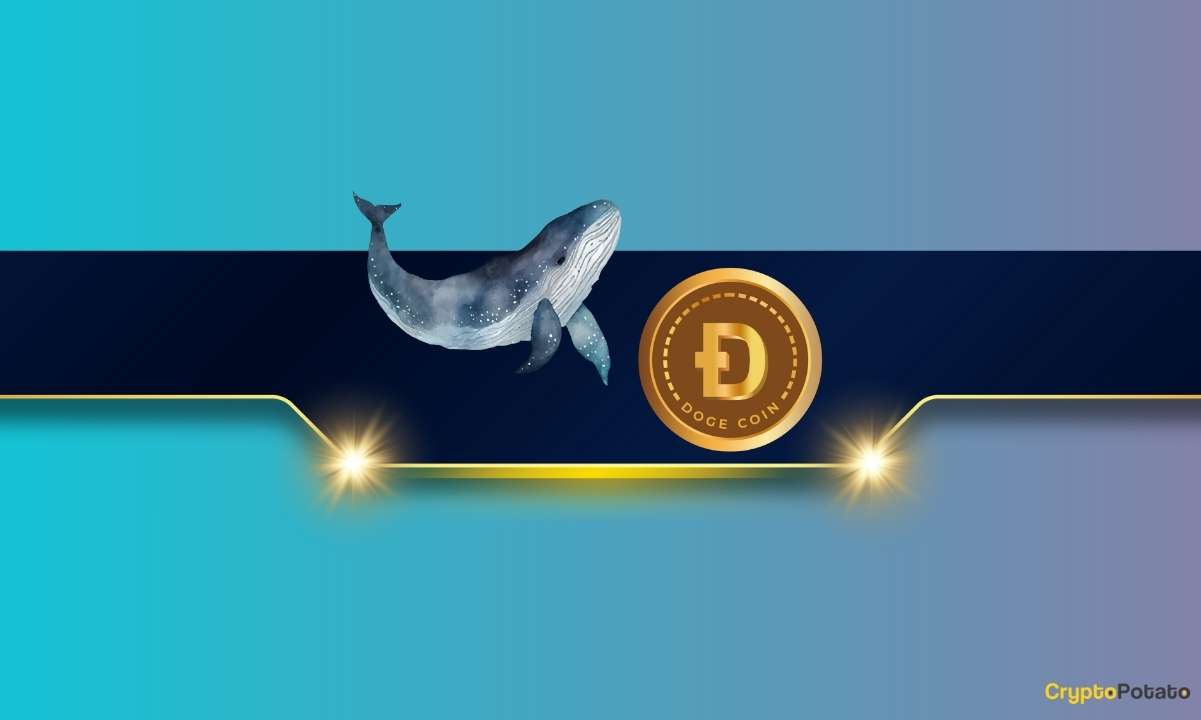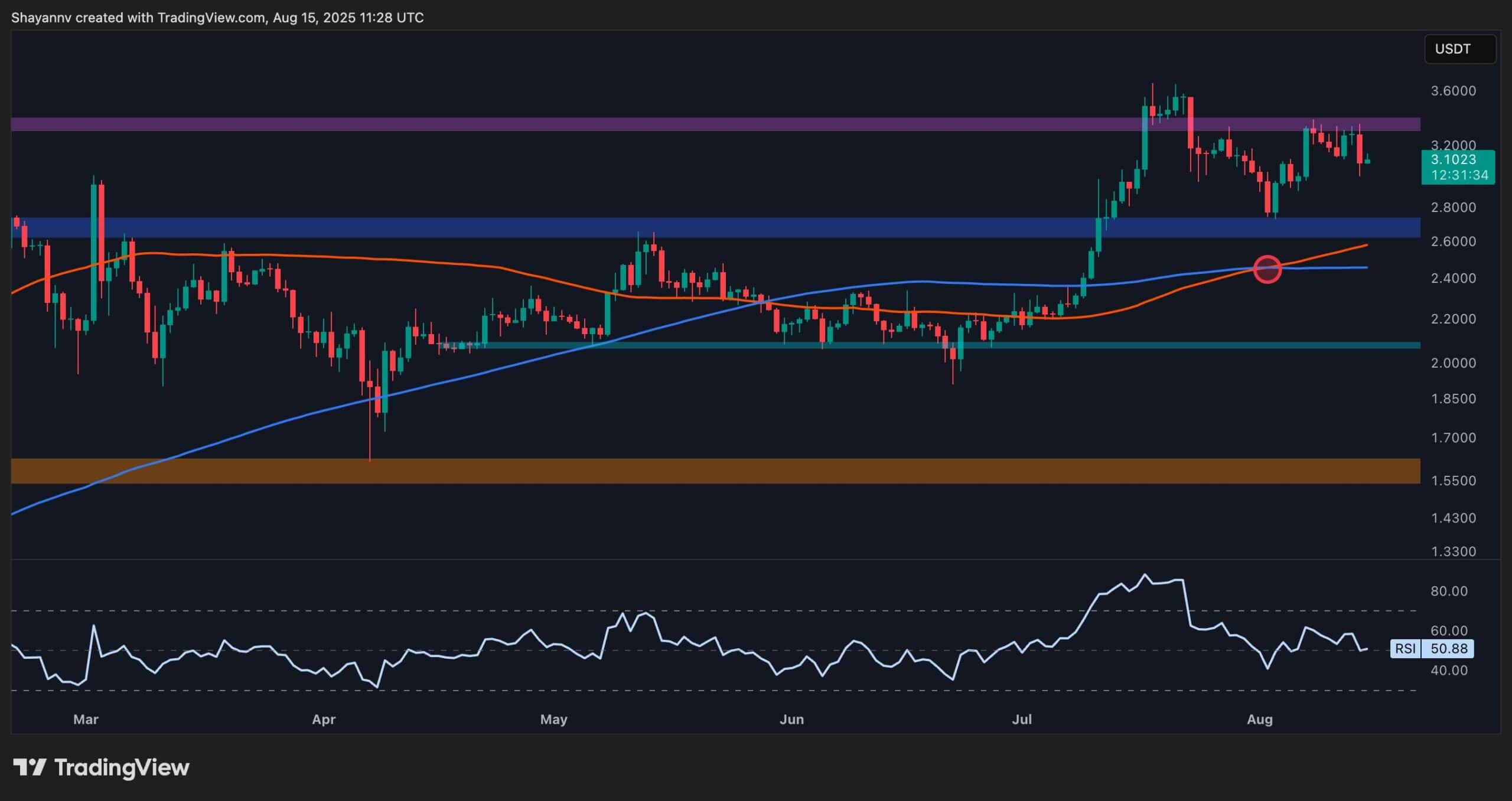Cryptocurrency
Security Matters: How’s Zircuit Planning to Mitigate Hacks in Web3 (Interview)

In the rapidly evolving landscape of Layer 2 networks, Zircuit aims to create a new approach to security and scalability. Co-founded by Martin Derka, a seasoned professional with a PhD in algorithms and complexity, sat with us for an interview during EthCC. Derka shared insights into his journey, the founding of Zircuit including the meaning of the whooping $3 billion staked ETH to the project, and above all – the expected launch date for Zircuit’s mainnet.
Multiple well-known investors have taken part in the protocol’s mainnet funding round, including Binance Labs, Nomad Capital, AMBER, and much more.
From Soccer to Crypto
Martin Derka’s journey into the world of crypto began after an unexpected turn in his career. “I have a PhD in algorithms and complexity,” Derka explained, detailing his academic background. “For many years, I was developing software for various companies while still a student.” His transition from academia to entrepreneurship was marked by a stint as CTO of a startup focused on car advertisement photography, which he co-founded in 2013. However, after internal disputes led to his departure in 2017, Derka sought new opportunities, eventually finding his way to the crypto sphere.
“After leaving the startup, I went to clear my head in Argentina and Chile,” Derka recounted. “Upon returning to Canada, I connected with Leo (Leonardo Passos, Ph.D), a former soccer buddy and one of the veteran employees of the crypto auditing giant Quantstamp.” This serendipitous meeting led to Derka joining Quantstamp as one of its earliest hires in 2018, where he delved deep into crypto security.
The Birth of Zircuit
Derka’s tenure at Quantstamp laid the groundwork for Zircuit. “At Quantstamp, we knew rollups would be key to scaling Ethereum,” Derka noted. This realization sparked intensive research into rollups, eventually leading to the inception of Zircuit. “We saw an amazing opportunity to enhance blockchain security proactively,” Derka said. “This is how the feature that now distinguishes Zircuit—sequencer level security—began.”
‘Many Uses of AI Seem Fabricated’
Zircuit’s most striking feature is its AI-driven security mechanism, sequencer-level security, a concept Derka elaborated on extensively.
“Our sequencer evaluates each transaction for malicious intent before inclusion in the block,” Derka explained. “We use AI to simulate transactions and assess their impact, determining if they’re hacks.” This proactive approach allows Zircuit to quarantine potentially harmful transactions, enhancing the overall security of the blockchain.
The sequencer is a privileged node designed to collect user transactions and order them based on predefined rules. In essence, once the transaction arrives at the sequencer, it is then routed to the “Malice Detection” module – something that the team refers to as the “oracle.” It’s designed to determine whether a transaction is benign or it can potentially be malicious. Those that are benign are queued for block inclusion, while those that are flagged are diverted to another module called “Quarantine-Release Criterion” module. It acts as a holding area for the time during which these transactions undergo a rigorous verification process.
The following can be seen in the overview presented by Zircuit:
When asked about the prevalent AI hype, Derka acknowledged the phenomenon but remained pragmatic. “There is a huge level of hype,” he admitted. “Many uses of AI seem fabricated, and AI can be highly inaccurate. But failure is part of innovation. If we don’t try applying AI in all possible areas, we might miss its true potential.”
L2’s: Do We Really Need That Many
Zircuit positions itself as a Layer 2 (L2) solution with a strong emphasis on security, amidst a crowded field of competitors. Derka was clear about the inevitability of multiple L2 solutions. “If we didn’t build another L2, someone else would,” he said. “The better question is why users should choose Zircuit over others, and that comes down to our unique security proposition.”
Despite the competitive market, Derka does not foresee a winner-takes-all scenario.
“Technologists love to build and compete,” he asserted. “There will always be new players challenging the status quo.”
Zircuit: When Mainnet Launch
Zircuit’s immediate focus is on launching its Mainnet, with significant milestones already achieved. “We launched our Testnet last year, which has been very stable,” Derka shared. “We are now in the process of deploying Mainnet, integrating partners, and ensuring security measures are in place.”
The Mainnet Phase 1 launch is scheduled for Augustmid-July in a gated mode, with a broader public launch expected soon afterin mid-August. “We are also working on optimizing zero-knowledge proof generation to reduce operating costs and improve efficiency,” Derka added. This technical enhancement is crucial for the blockchain’s functionality and user experience.
Over $3 Billion in Staked ETH
Derka is mindful of the challenges in sustaining Zircuit’s initial success: With over $3 billion in restaked Ether (at its peak) signaling strong interest, the true test will be retaining these funds post-launch. “It’s the best signal we currently have, but it’s not a guarantee of success,” Derka cautioned. “Our task is to support projects deploying on Zircuit, ensuring they attract and retain capital.”
Zircuit aims to create a robust ecosystem encompassing all essential blockchain functions. “We want a fully functional ecosystem comparable to other chains, with lending protocols, oracles, DEXs, and stablecoins,” Derka explained. The security aspect remains a key differentiator, offering users and developers a more secure environment for their projects.
Binance Free $600 (CryptoPotato Exclusive): Use this link to register a new account and receive $600 exclusive welcome offer on Binance (full details).
LIMITED OFFER 2024 at BYDFi Exchange: Up to $2,888 welcome reward, use this link to register and open a 100 USDT-M position for free!
Cryptocurrency
Ethereum Foundation, Whales, and Hackers: What’s Driving the ETH Sell-Off?

TL;DR
- Whales, hackers, and the Ethereum Foundation wallets moved over $500M in ETH through large sales and withdrawals.
- Ethereum transfers rose to 4.6M ETH, nearing the monthly high of 5.2M recorded in July.
- Staking inflows hit 247,900 ETH, the highest in a month, locking more supply from trading.
Large Withdrawals and Whale Activity
Ethereum (ETH) has seen heavy movement from major wallets over the past few days. On-chain data from Lookonchain shows a newly created wallet pulled 17,591 ETH, worth $81.62 million, from Kraken in just two hours.
Over three days, two new wallets withdrew a combined 71,025 ETH, valued at $330 million, from the exchange.
One of these wallets, address 0x2A92, has withdrawn 53,434 ETH, worth $242.34 million, in two days. This includes a recent purchase of 30,069 ETH, valued at $138.46 million, during a market drop.
Major ETH Holders Offload Millions Amid Price Rally
In contrast, several separate entities have been disposing of some ETH holdings. A wallet tied to a hacker address 0x17E0 sold 4,958 ETH for $22.13 million at $4,463, securing a profit of $9.75 million. Earlier this year, the same address sold 12,282 ETH at $1,932 and later bought back part of the amount at higher prices.
A different whale sold 20,600 ETH for $96.55 million over the past two days, generating a profit of more than $26 million after holding the position for nine months.
Meanwhile, an Ethereum Foundation-linked wallet, 0xF39d, sold 6,194 ETH worth $28.36 million in the last three days at an average price of $4,578.
Recent sales from the same wallet included an additional 1,100 ETH and 1,695 ETH for over $12.7 million combined.
The #EthereumFoundation-linked wallet(0xF39d) sold another 1,300 $ETH($5.87M) at $4,518 ~11 hours ago.
Over the past 3 days, this wallet has sold a total of 6,194 $ETH($28.36M) at an average price of $4,578.https://t.co/4hfCWymHVG pic.twitter.com/ErUyEY8SJy
— Lookonchain (@lookonchain) August 15, 2025
Network Activity on the Rise
CryptoQuant data shows Ethereum’s total tokens transferred have been climbing since August 9. After ranging between 1 million and 3 million ETH through late July and early August, transfers have risen to 4.6 million ETH, approaching the monthly high of 5.2 million recorded in mid-July. This increase has occurred alongside a price rally from about $3,400 to $4,600.
Interestingly, staking inflows generally stayed between 20,000 and 80,000 ETH per day over the past month. On August 14, inflows jumped to 247,900 ETH, the highest in the period.
At the time, ETH was trading near $4,600. Large staking deposits reduce the amount of ETH available for immediate trading, as staked coins are locked for a set period.
In the meantime, ETH trades at $4,647 with a 24-hour volume of $68.25 billion, down 2% on the day but up 19% over the week.
Binance Free $600 (CryptoPotato Exclusive): Use this link to register a new account and receive $600 exclusive welcome offer on Binance (full details).
LIMITED OFFER for CryptoPotato readers at Bybit: Use this link to register and open a $500 FREE position on any coin!
Cryptocurrency
Massive DOGE Whale Activity Hints at $1 Breakout

TL;DR
- Whales bought two billion DOGE this week, lifting their combined holdings to 27.6 billion coins.
- A single 900M DOGE transfer worth $208M to Binance drew attention to large exchange movements.
- DOGE broke key resistance, with momentum building for a possible push toward the $1 price mark.
Price and Market Moves
Dogecoin (DOGE) traded at $0.23 at press time, slipping 4% over the past day but still showing a 2% gain for the week. Daily turnover came in at about $6.18 billion.
Meanwhile, the broader crypto market saw over $1 billion in liquidations. Hotter-than-expected US Producer Price Index data pushed traders to scale back expectations of a near-term Federal Reserve rate cut. DOGE had roughly 290,500 coins liquidated during the sell-off.
On the two-week chart, analyst Trader Tardigrade notes that DOGE has cleared a downward-sloping resistance line after completing what appears to be a “wave V” in an Elliott Wave sequence. Similar setups in the past, where prolonged declines stayed within falling channels before breaking higher, have been followed by sharp rallies.
$Doge/2-week#Dogecoin is gaining strong momentum to surge above $1 pic.twitter.com/TuSEKr19nv
— Trader Tardigrade (@TATrader_Alan) August 15, 2025
Momentum gauges are also turning up. The Stochastic RSI, which had dropped into oversold territory, is now heading higher. Previous reversals from this zone have coincided with sustained upward moves. The current formation points to a possible run that could carry DOGE past the $1 mark.
Heavy Whale Buying and Large Transfers
As reported by CryptoPotato, blockchain data shows large investors have added two billion DOGE in the past week, spending just under $500 million. That brings their holdings to about 27.6 billion coins, or 18% of the supply. The buying streak has prompted speculation within the community.
Recently, Whale Alert flagged a 900 million DOGE transfer worth about $208 million into Binance. The tracking indicates that it originated from a wallet connected to the exchange, likely as an internal activity. The address involved holds 2.88 billion DOGE, one of the largest balances on the network.
Ali Martinez also reports that transactions above $1 million reached a one-month high, with activity building since early August and peaking as DOGE traded at $0.25.
Whales are back! Dogecoin $DOGE activity at a 1-month high. pic.twitter.com/C83Pv68mCt
— Ali (@ali_charts) August 14, 2025
Sentiment Building
Analyst Gordon described the current setup as “a nice bit of consolidation” before a potential breakout, adding,
“This will be one of the first coins normies FLOCK to & the pump will be MASSIVE.”
With whale accumulation rising, high-value transfers increasing, and a bullish technical pattern in play, DOGE is positioned for a potential push toward $1 if momentum holds.
Binance Free $600 (CryptoPotato Exclusive): Use this link to register a new account and receive $600 exclusive welcome offer on Binance (full details).
LIMITED OFFER for CryptoPotato readers at Bybit: Use this link to register and open a $500 FREE position on any coin!
Cryptocurrency
Ripple Price Analysis: XRP at Risk as Key Support Levels Could Trigger Sharp Drop

XRP has recently entered a consolidation phase after a strong rally earlier this summer, with the price action now hovering around key resistance levels on both its USDT and BTC pairs. Yet, while momentum has slowed, the charts still indicate a generally bullish structure, with multiple key support levels remaining firmly in place.
Technical Analysis
By ShayanMarkets
The USDT Pair
On the XRP/USDT daily chart, the price is currently trading near the $3.10 mark, facing a strong resistance zone around $3.40. This follows a breakout above the $2.70 range in July, which has now flipped into a support area.
Both the 100-day and 200-day moving averages are also trending upward and recently formed a bullish crossover around $2.45, reinforcing the medium-term bullish sentiment. If the $3.40 resistance breaks, a push toward the critical $4.00 range becomes likely.
However, the RSI hovering near the neutral 50 level suggests a lack of strong momentum for now, meaning a short-term pullback into the $2.80 support zone is still possible.
This zone will be key for maintaining the bullish structure. Losing it could open the door for a deeper correction toward the 200-day moving average located around the $2.40 mark. Yet, as long as the price stays above the moving averages, the broader trend remains bullish.
The BTC Pair
Looking at the XRP/BTC chart, the pair has recently pulled back after hitting the 3,000 SAT resistance, with the price currently around 2,600 SAT.
This follows a clean breakout above the long-term descending channel and a successful retest of its upper boundary, which coincided with the 200-day moving average and the 2,400 SAT support zone. This confluence remains a key bullish technical factor, as holding above it could attract renewed buying pressure.
That said, RSI levels around 48 show that momentum has cooled after the sharp July rally, meaning XRP may continue ranging between 2,400 SAT and 3,000 SAT in the near term. A decisive close above 3,000 SAT would likely open the path to the 3,400 SAT zone, while losing 2,400 SAT could shift the bias back toward 2,000 SAT support. For now, the structure still favors the bulls as long as higher lows remain intact.
Binance Free $600 (CryptoPotato Exclusive): Use this link to register a new account and receive $600 exclusive welcome offer on Binance (full details).
LIMITED OFFER for CryptoPotato readers at Bybit: Use this link to register and open a $500 FREE position on any coin!
Disclaimer: Information found on CryptoPotato is those of writers quoted. It does not represent the opinions of CryptoPotato on whether to buy, sell, or hold any investments. You are advised to conduct your own research before making any investment decisions. Use provided information at your own risk. See Disclaimer for more information.
Cryptocurrency charts by TradingView.

 Forex3 years ago
Forex3 years agoForex Today: the dollar is gaining strength amid gloomy sentiment at the start of the Fed’s week

 Forex3 years ago
Forex3 years agoUnbiased review of Pocket Option broker

 Forex3 years ago
Forex3 years agoDollar to pound sterling exchange rate today: Pound plummeted to its lowest since 1985

 Forex3 years ago
Forex3 years agoHow is the Australian dollar doing today?

 Cryptocurrency3 years ago
Cryptocurrency3 years agoWhat happened in the crypto market – current events today

 World3 years ago
World3 years agoWhy are modern video games an art form?

 Commodities3 years ago
Commodities3 years agoCopper continues to fall in price on expectations of lower demand in China

 Economy3 years ago
Economy3 years agoCrude oil tankers double in price due to EU anti-Russian sanctions

























